Construction of beds
for hardy Cactus,
and how to grow and propagate them.
Construction of
beds to hardy succulents:
Growing Hardy succulents
and other drought resistant plants from seeds:
Fertilizer:
Diseases in hardy
succulents:
A few good plants
for beginners:
Propagation of hardy cactus and other
hardy succulents.
Construction of beds to hardy succulents:
The bed must raised and lean to the south
(on the Northern hemisphere!!), so the plants get "baked" by as much sun
as possible. To raise the bed above the subsoil, I use granite boulders.
In the bottom of all beds there are a 20 to 40 cm thick layer of granite
boulders, on top of this a 5 cm layer of gravel (1 to 3-4 cm across),
and above this a 15 to 25 cm layer of the soil where the plants shall grow
in. The soil that I use is gravely sand with lot of stones in all sizes.
The sand down to dust like clay. On top of it all I have a 3-5 cm layer
of 1- 1,8 cm granite chippings. The granite chippings will help keeping
the root neck dry, and prevent that the rain splashes soil on the plants. |
|
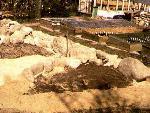
Construction of my bed for plants from
South Dakota.
June 1995.
|
| On the
picture to the right you can see that the granite stones for drainage are
on their place, and the large stone for walking too. All that miss is the
small stones the gravely sand, the granite chippings and you can plant
the cactus. |
|
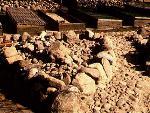
This bed is for my plants from Utah.
June 1995.
|
It is
also important that there are many large rocks, they are important when
you have to walk in the bed, and they make a healthy micro climate for
the plants.
It is not advisable to walk on the soil,
while the roots of Opuntia is just below the surface of the soil, and often
just below the granite chippings. |
|
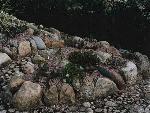
Bed with plants from South Dakota.
June 1998.
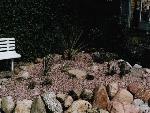
Bed with plants from Utah.
June 1998.
|
| Care
during the winter:
Here in Northern Denmark, it is best for
the hardy succulents, that they are protected against winter moisture.
This can be done with a sheet of glass or another clear material. If you
grow very moisture sensitive species, it's best to cover the entire bed. |
|
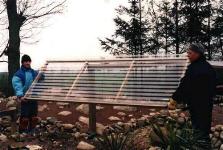
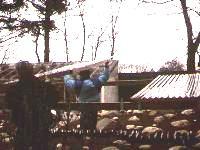
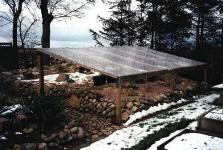
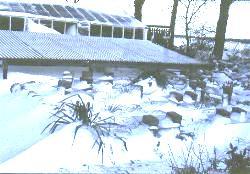
|
Fertilizer:
In a Cactusbed made mentioned above the roots
of many plants will go down to underlying strata in search of minerals.
Rainwater and dust from the
atmosphere will also carry small amounts of minerals to the bed, most
importantly nitrogen (as nitrate), which may be sufficient for the most
Cactus and other slow growing plants.
I do however fertilize my cactus, as this make the plants more healthy,
hardy and bloom more.
I make my own fertilizer, it's made of
this:
1 liter solid potassium phosphate 0-22-28
1 liter liquid fertilizer with trace minerals.
I use the brand "Hornum gødning"
8 liter water.
Put 1 liter potassium phosphate in a 10
liter can and add 4-5 liter warm water (NOT HOT WATER!!!!), when it's dissolved
(needs a lot of shaking!!!), I add 1 liter liquid fertilizer and finally
I fill the can with cold water.
The above fertilizer is used in this strength:
1 dl. to 10 liter water which is enough
for 10 square meters.
I fertilize every two weeks from May 15th
to August 15th, and always in the morning before the sun hit the plants
(or on a rainy day). Remember! to rinse away the fertilizer
on the plants, or they might get burned spots on the leaves, by the remaining
fertilizer salts!!!! I just give the plants a quick shower with tap
water.
Diseases in
hardy succulents:
There can occur rust fungus, specially
after a wet warm winter, If the damage is done there are noting to do,
but the rust fungus rarely spread to the new growth, so next year you can
make new cuttings and start it over again. The rust fungus can be prevented
if the bed with the plants are protected against winter moisture from May
1th to October 1th., or with a sheet of glass above each plant.
In the spring is is important to watch
out for pads that are beginning to rot, while it can very fast spread to
the whole plant. All the infected pads has to be cut of with a sharp knife,
until there are no more "orange" to see in the cut. But even with only
a little piece left of the Opuntia pad it will grow to a new plant (hardy
Opuntias are tuff plants)
Snails and slugs can be a little hard on
the new growth, and they can be killed with poison or with the beer method!
I have never had other diseased in my hardy
succulents.
| A
dozen of good plants for beginners:
The number is my "catalogue number" and
the letter shows if it's a clone of the same plant.
All of the below plants are hardy in an
unprotected bed:
|
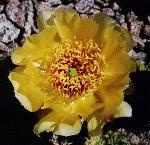 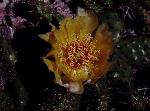
Photos by Benny Moeller Jensen © 1999
29. Opuntia
' Smithwick '
from South Dakota. large yellow flowers
with red stamens. This is just the best bloomer and the best hardy cactus
there is! |

Photo by Benny Moeller Jensen © 1999
35.
Opuntia
' Budapest '
dark green shiny pads, greenish yellow
flowers, shy bloomer. |

Photo by Lary J. Junge, Colorado ©.
40.
Opuntia
' Hybrid '
rose - red flowers, fat pads with thick
white spines, good bloomer. |
| |
|
|
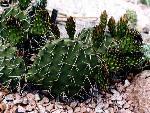 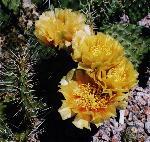
Photo by Benny Moeller Jensen © 1999
173.
Opuntia
cymochila
Larimer Co., Colorado,DJF933.13, large
dark green pads with white spines, large yellow flowers.
Large yellow flowers that fade to orange
the second day,
Wonderful large dark green pads with white
spines .
Very hardy from, grown without protection |
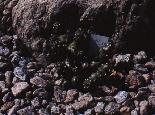
Photo by Benny Moeller Jensen © 1999
61A.
Opuntia
fragilis
from South East Colorado, 2 - 3 cm long
small round pads with few red-brown spines, flowers unknown (most likely
yellow!) |
Photo
here soon!
227.
Opuntia fragilis var. brooksii
n.n.
from Russell Co., Kansas, small pads with
many spines, yellow flowers with red stamens, good bloomer.
|
| Photo
here soon!
680.
Opuntia fragilis ' Smørblomst
'
small pads with MANY white spines, yellow
flowers.
|

Photo by Benny Moeller Jensen © 1999
674
Opuntia humifusa
from South Dakota, yellow flowers with
red center.
|
Photo
here soon!
242.
Opuntia tortispina
pale yellow flowers, has purple fruits
the following year. VERY HARDY, but a shy bloomer.
|
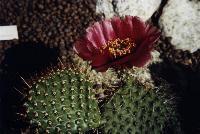 
Photo by Benny Moeller Jensen © 1999
11.
Opuntia
polyacantha ' Carmin '
from South Dakota, 7 - 10 cm round pads,
with MANY white spines, that starts as brown-red on the new pads, carmine
flowers, good bloomer.
|
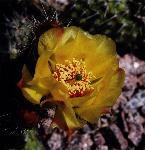 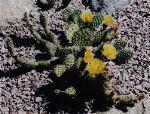
Photo by Benny Moeller Jensen © 1999
117.
Opuntia
polyacantha
from Weld Co., Colorado. 7 - 10 cm round
pads with white pads, yellow flowers.
|
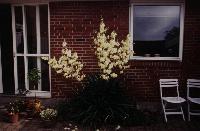
Photo by Benny Moeller Jensen © 2000
49.
Yucca flaccida
This is the most hardy Yucca, dark green
floppy leaves, tall inflorescence with white flowers.
|
There are many other good plants
that I could mention, you can take a look at
my
plant list to see which species I grow this far north in Denmark. Or
you could visit my Photo gallery.
! Photo gallery ! Yucca
! Hardy Cactus ! E-mail
! DANSK ! Home !
Caudex
index ! Cucurbitaceae (Danish text!)
! Links ! Search
! NEWS ! Wanted !
! Web shop !
Copyright © 1998-2009
Benny Møller Jensen
Hjørring
Danmark